SOCY100 Final Exam: Social Constructions, Deviance, and Inequality
VerifiedAdded on 2022/11/18
|19
|4749
|242
Homework Assignment
AI Summary
This document presents the SOCY100 final exam, addressing key sociological concepts. The exam explores how social factors influence the choice of romantic partners, differing from common sense perspectives. It examines the social construction of reality, professional attire, and the reinforcement of social inequalities. The document also analyzes deviance through the lens of social conflict theory, using tax evasion as an example. Furthermore, it discusses social movements related to the school-to-prison pipeline, employing social movement theories to explain a successful campaign. The exam also examines how historical practices of discrimination in real estate, such as redlining, contribute to inequalities in education and wealth accumulation. Finally, the document differentiates between discrimination and institutional discrimination, providing examples and explaining their impact. The assignment is a comprehensive analysis of core sociological concepts, providing insightful perspectives on various social issues.
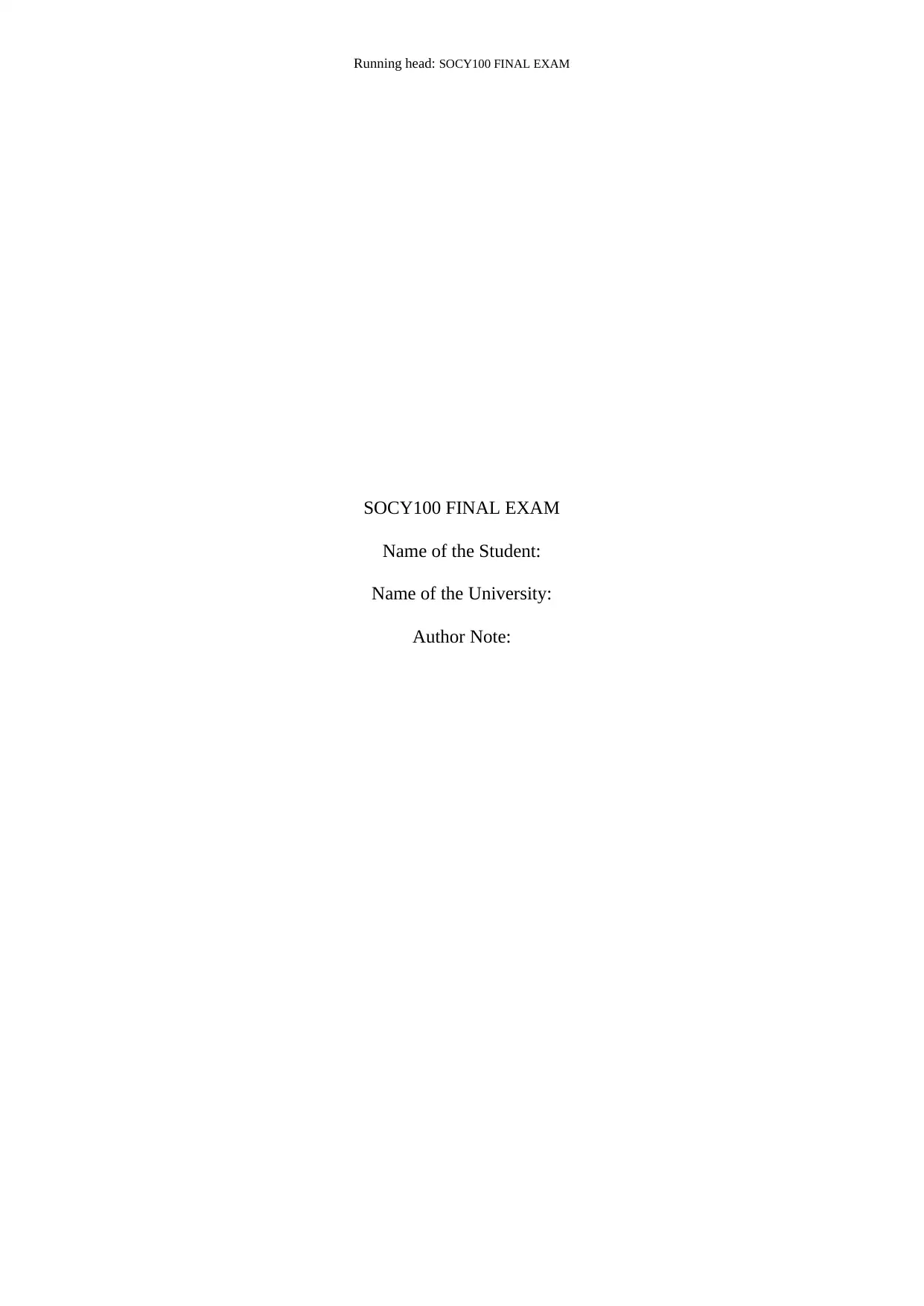
Running head: SOCY100 FINAL EXAM
SOCY100 FINAL EXAM
Name of the Student:
Name of the University:
Author Note:
SOCY100 FINAL EXAM
Name of the Student:
Name of the University:
Author Note:
Paraphrase This Document
Need a fresh take? Get an instant paraphrase of this document with our AI Paraphraser
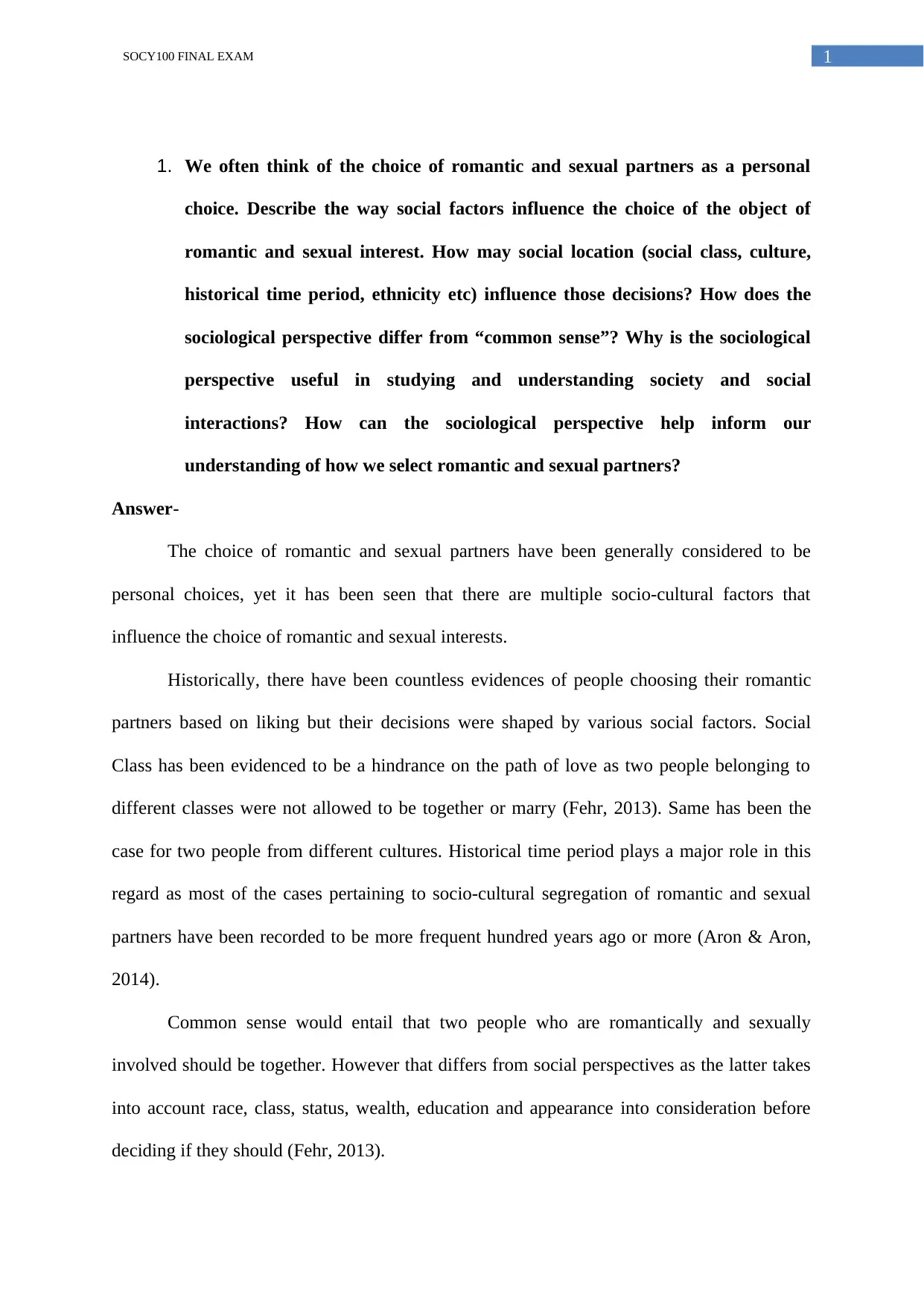
1SOCY100 FINAL EXAM
1. We often think of the choice of romantic and sexual partners as a personal
choice. Describe the way social factors influence the choice of the object of
romantic and sexual interest. How may social location (social class, culture,
historical time period, ethnicity etc) influence those decisions? How does the
sociological perspective differ from “common sense”? Why is the sociological
perspective useful in studying and understanding society and social
interactions? How can the sociological perspective help inform our
understanding of how we select romantic and sexual partners?
Answer-
The choice of romantic and sexual partners have been generally considered to be
personal choices, yet it has been seen that there are multiple socio-cultural factors that
influence the choice of romantic and sexual interests.
Historically, there have been countless evidences of people choosing their romantic
partners based on liking but their decisions were shaped by various social factors. Social
Class has been evidenced to be a hindrance on the path of love as two people belonging to
different classes were not allowed to be together or marry (Fehr, 2013). Same has been the
case for two people from different cultures. Historical time period plays a major role in this
regard as most of the cases pertaining to socio-cultural segregation of romantic and sexual
partners have been recorded to be more frequent hundred years ago or more (Aron & Aron,
2014).
Common sense would entail that two people who are romantically and sexually
involved should be together. However that differs from social perspectives as the latter takes
into account race, class, status, wealth, education and appearance into consideration before
deciding if they should (Fehr, 2013).
1. We often think of the choice of romantic and sexual partners as a personal
choice. Describe the way social factors influence the choice of the object of
romantic and sexual interest. How may social location (social class, culture,
historical time period, ethnicity etc) influence those decisions? How does the
sociological perspective differ from “common sense”? Why is the sociological
perspective useful in studying and understanding society and social
interactions? How can the sociological perspective help inform our
understanding of how we select romantic and sexual partners?
Answer-
The choice of romantic and sexual partners have been generally considered to be
personal choices, yet it has been seen that there are multiple socio-cultural factors that
influence the choice of romantic and sexual interests.
Historically, there have been countless evidences of people choosing their romantic
partners based on liking but their decisions were shaped by various social factors. Social
Class has been evidenced to be a hindrance on the path of love as two people belonging to
different classes were not allowed to be together or marry (Fehr, 2013). Same has been the
case for two people from different cultures. Historical time period plays a major role in this
regard as most of the cases pertaining to socio-cultural segregation of romantic and sexual
partners have been recorded to be more frequent hundred years ago or more (Aron & Aron,
2014).
Common sense would entail that two people who are romantically and sexually
involved should be together. However that differs from social perspectives as the latter takes
into account race, class, status, wealth, education and appearance into consideration before
deciding if they should (Fehr, 2013).
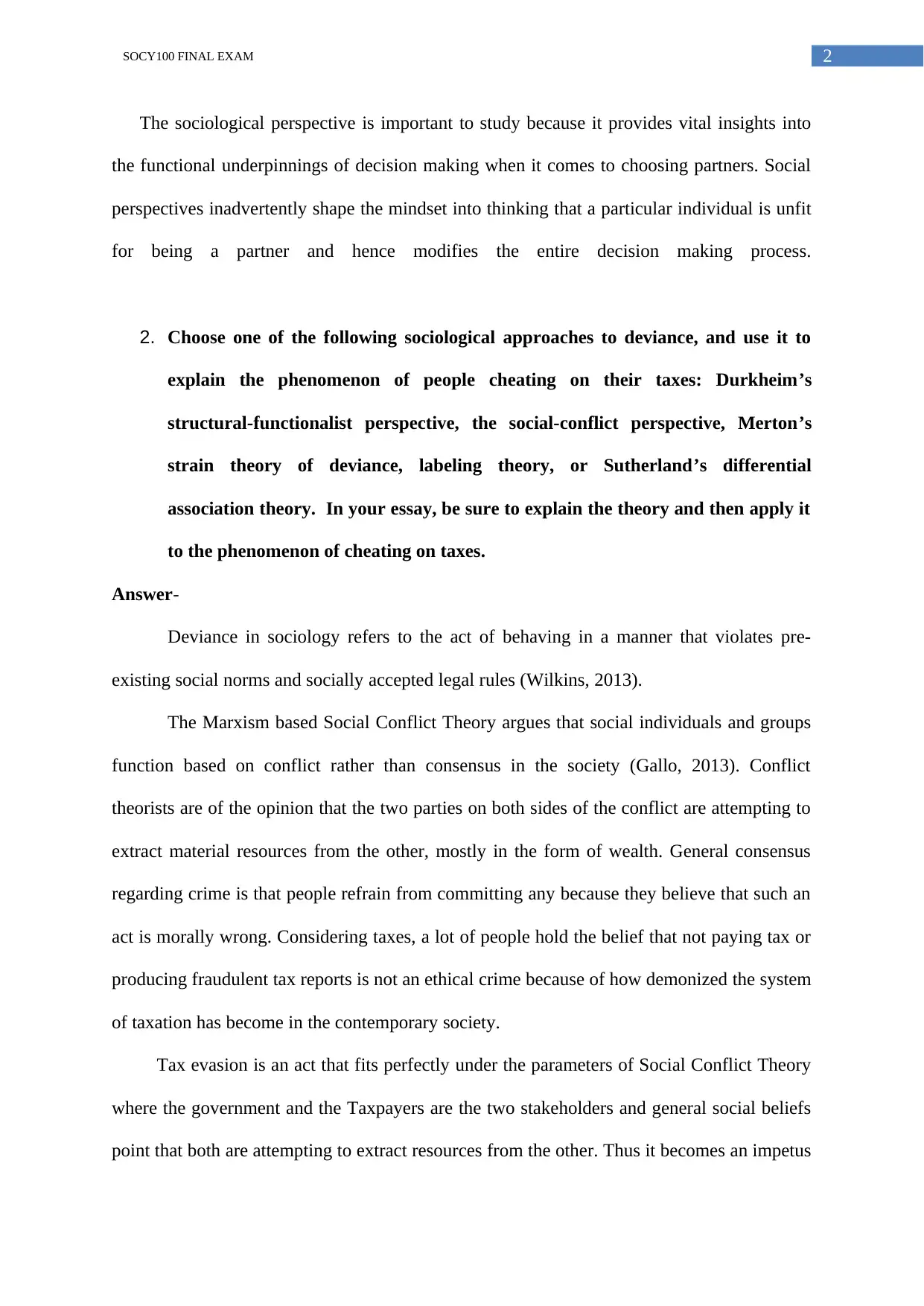
2SOCY100 FINAL EXAM
The sociological perspective is important to study because it provides vital insights into
the functional underpinnings of decision making when it comes to choosing partners. Social
perspectives inadvertently shape the mindset into thinking that a particular individual is unfit
for being a partner and hence modifies the entire decision making process.
2. Choose one of the following sociological approaches to deviance, and use it to
explain the phenomenon of people cheating on their taxes: Durkheim’s
structural-functionalist perspective, the social-conflict perspective, Merton’s
strain theory of deviance, labeling theory, or Sutherland’s differential
association theory. In your essay, be sure to explain the theory and then apply it
to the phenomenon of cheating on taxes.
Answer-
Deviance in sociology refers to the act of behaving in a manner that violates pre-
existing social norms and socially accepted legal rules (Wilkins, 2013).
The Marxism based Social Conflict Theory argues that social individuals and groups
function based on conflict rather than consensus in the society (Gallo, 2013). Conflict
theorists are of the opinion that the two parties on both sides of the conflict are attempting to
extract material resources from the other, mostly in the form of wealth. General consensus
regarding crime is that people refrain from committing any because they believe that such an
act is morally wrong. Considering taxes, a lot of people hold the belief that not paying tax or
producing fraudulent tax reports is not an ethical crime because of how demonized the system
of taxation has become in the contemporary society.
Tax evasion is an act that fits perfectly under the parameters of Social Conflict Theory
where the government and the Taxpayers are the two stakeholders and general social beliefs
point that both are attempting to extract resources from the other. Thus it becomes an impetus
The sociological perspective is important to study because it provides vital insights into
the functional underpinnings of decision making when it comes to choosing partners. Social
perspectives inadvertently shape the mindset into thinking that a particular individual is unfit
for being a partner and hence modifies the entire decision making process.
2. Choose one of the following sociological approaches to deviance, and use it to
explain the phenomenon of people cheating on their taxes: Durkheim’s
structural-functionalist perspective, the social-conflict perspective, Merton’s
strain theory of deviance, labeling theory, or Sutherland’s differential
association theory. In your essay, be sure to explain the theory and then apply it
to the phenomenon of cheating on taxes.
Answer-
Deviance in sociology refers to the act of behaving in a manner that violates pre-
existing social norms and socially accepted legal rules (Wilkins, 2013).
The Marxism based Social Conflict Theory argues that social individuals and groups
function based on conflict rather than consensus in the society (Gallo, 2013). Conflict
theorists are of the opinion that the two parties on both sides of the conflict are attempting to
extract material resources from the other, mostly in the form of wealth. General consensus
regarding crime is that people refrain from committing any because they believe that such an
act is morally wrong. Considering taxes, a lot of people hold the belief that not paying tax or
producing fraudulent tax reports is not an ethical crime because of how demonized the system
of taxation has become in the contemporary society.
Tax evasion is an act that fits perfectly under the parameters of Social Conflict Theory
where the government and the Taxpayers are the two stakeholders and general social beliefs
point that both are attempting to extract resources from the other. Thus it becomes an impetus
⊘ This is a preview!⊘
Do you want full access?
Subscribe today to unlock all pages.

Trusted by 1+ million students worldwide
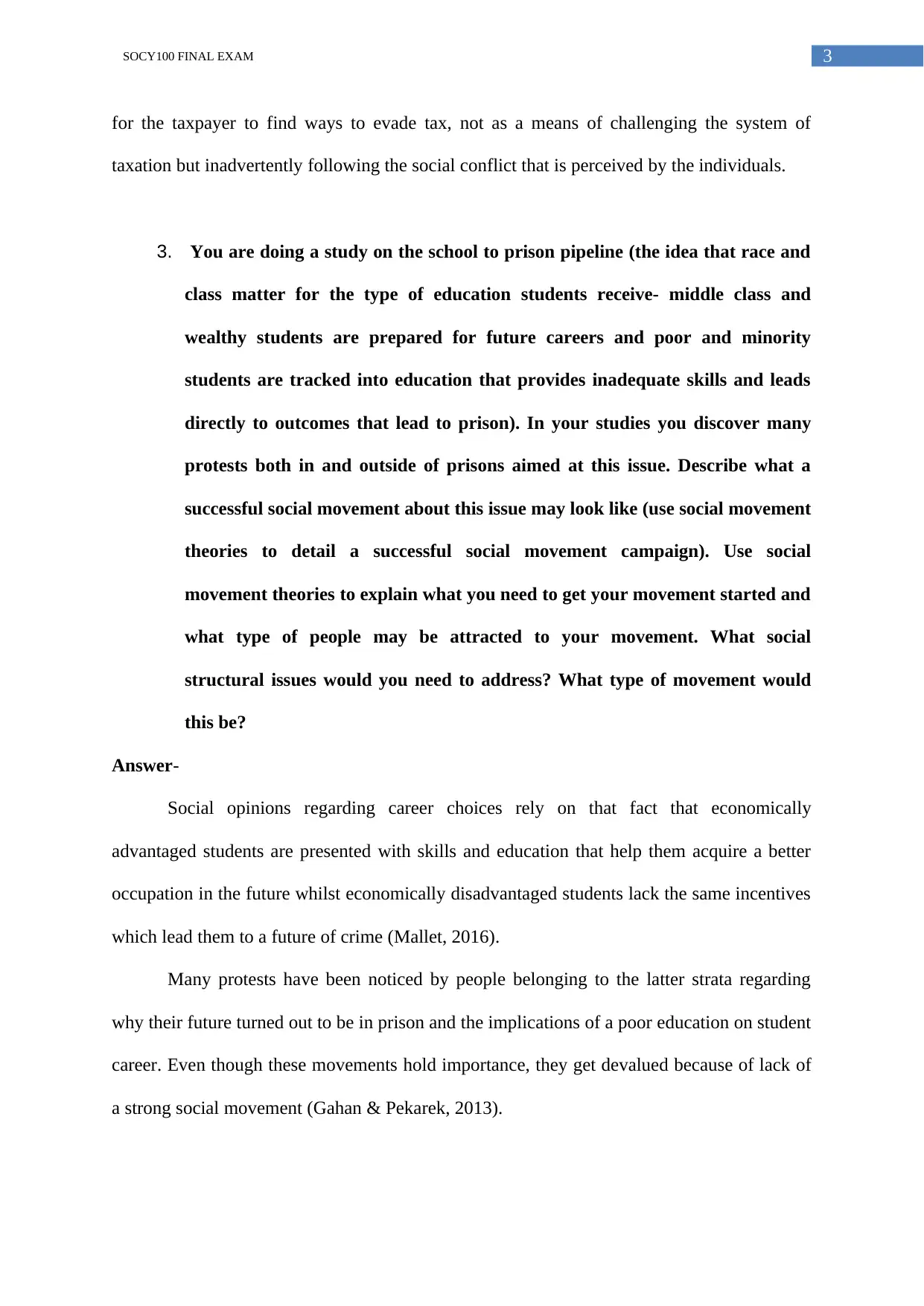
3SOCY100 FINAL EXAM
for the taxpayer to find ways to evade tax, not as a means of challenging the system of
taxation but inadvertently following the social conflict that is perceived by the individuals.
3. You are doing a study on the school to prison pipeline (the idea that race and
class matter for the type of education students receive- middle class and
wealthy students are prepared for future careers and poor and minority
students are tracked into education that provides inadequate skills and leads
directly to outcomes that lead to prison). In your studies you discover many
protests both in and outside of prisons aimed at this issue. Describe what a
successful social movement about this issue may look like (use social movement
theories to detail a successful social movement campaign). Use social
movement theories to explain what you need to get your movement started and
what type of people may be attracted to your movement. What social
structural issues would you need to address? What type of movement would
this be?
Answer-
Social opinions regarding career choices rely on that fact that economically
advantaged students are presented with skills and education that help them acquire a better
occupation in the future whilst economically disadvantaged students lack the same incentives
which lead them to a future of crime (Mallet, 2016).
Many protests have been noticed by people belonging to the latter strata regarding
why their future turned out to be in prison and the implications of a poor education on student
career. Even though these movements hold importance, they get devalued because of lack of
a strong social movement (Gahan & Pekarek, 2013).
for the taxpayer to find ways to evade tax, not as a means of challenging the system of
taxation but inadvertently following the social conflict that is perceived by the individuals.
3. You are doing a study on the school to prison pipeline (the idea that race and
class matter for the type of education students receive- middle class and
wealthy students are prepared for future careers and poor and minority
students are tracked into education that provides inadequate skills and leads
directly to outcomes that lead to prison). In your studies you discover many
protests both in and outside of prisons aimed at this issue. Describe what a
successful social movement about this issue may look like (use social movement
theories to detail a successful social movement campaign). Use social
movement theories to explain what you need to get your movement started and
what type of people may be attracted to your movement. What social
structural issues would you need to address? What type of movement would
this be?
Answer-
Social opinions regarding career choices rely on that fact that economically
advantaged students are presented with skills and education that help them acquire a better
occupation in the future whilst economically disadvantaged students lack the same incentives
which lead them to a future of crime (Mallet, 2016).
Many protests have been noticed by people belonging to the latter strata regarding
why their future turned out to be in prison and the implications of a poor education on student
career. Even though these movements hold importance, they get devalued because of lack of
a strong social movement (Gahan & Pekarek, 2013).
Paraphrase This Document
Need a fresh take? Get an instant paraphrase of this document with our AI Paraphraser
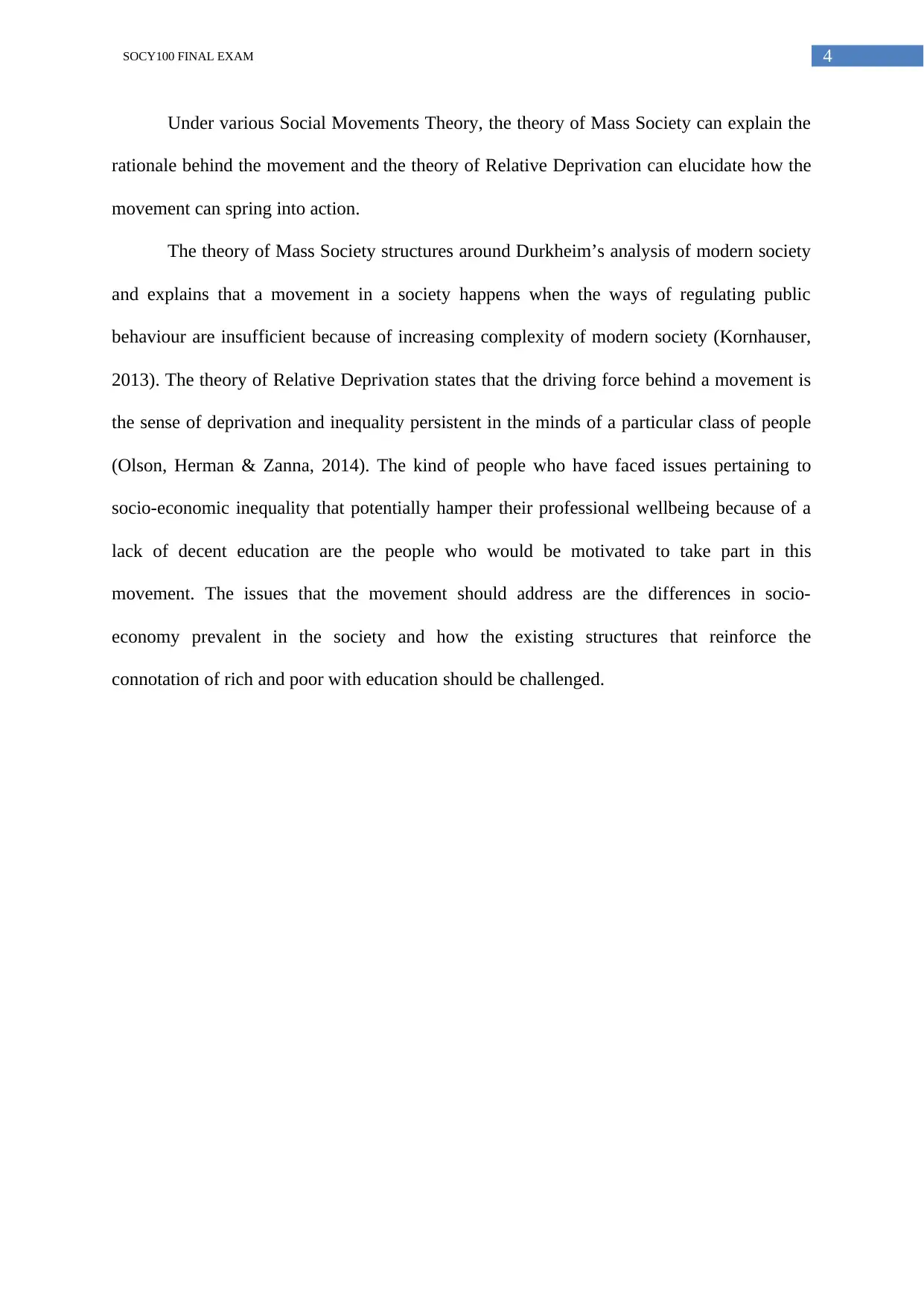
4SOCY100 FINAL EXAM
Under various Social Movements Theory, the theory of Mass Society can explain the
rationale behind the movement and the theory of Relative Deprivation can elucidate how the
movement can spring into action.
The theory of Mass Society structures around Durkheim’s analysis of modern society
and explains that a movement in a society happens when the ways of regulating public
behaviour are insufficient because of increasing complexity of modern society (Kornhauser,
2013). The theory of Relative Deprivation states that the driving force behind a movement is
the sense of deprivation and inequality persistent in the minds of a particular class of people
(Olson, Herman & Zanna, 2014). The kind of people who have faced issues pertaining to
socio-economic inequality that potentially hamper their professional wellbeing because of a
lack of decent education are the people who would be motivated to take part in this
movement. The issues that the movement should address are the differences in socio-
economy prevalent in the society and how the existing structures that reinforce the
connotation of rich and poor with education should be challenged.
Under various Social Movements Theory, the theory of Mass Society can explain the
rationale behind the movement and the theory of Relative Deprivation can elucidate how the
movement can spring into action.
The theory of Mass Society structures around Durkheim’s analysis of modern society
and explains that a movement in a society happens when the ways of regulating public
behaviour are insufficient because of increasing complexity of modern society (Kornhauser,
2013). The theory of Relative Deprivation states that the driving force behind a movement is
the sense of deprivation and inequality persistent in the minds of a particular class of people
(Olson, Herman & Zanna, 2014). The kind of people who have faced issues pertaining to
socio-economic inequality that potentially hamper their professional wellbeing because of a
lack of decent education are the people who would be motivated to take part in this
movement. The issues that the movement should address are the differences in socio-
economy prevalent in the society and how the existing structures that reinforce the
connotation of rich and poor with education should be challenged.
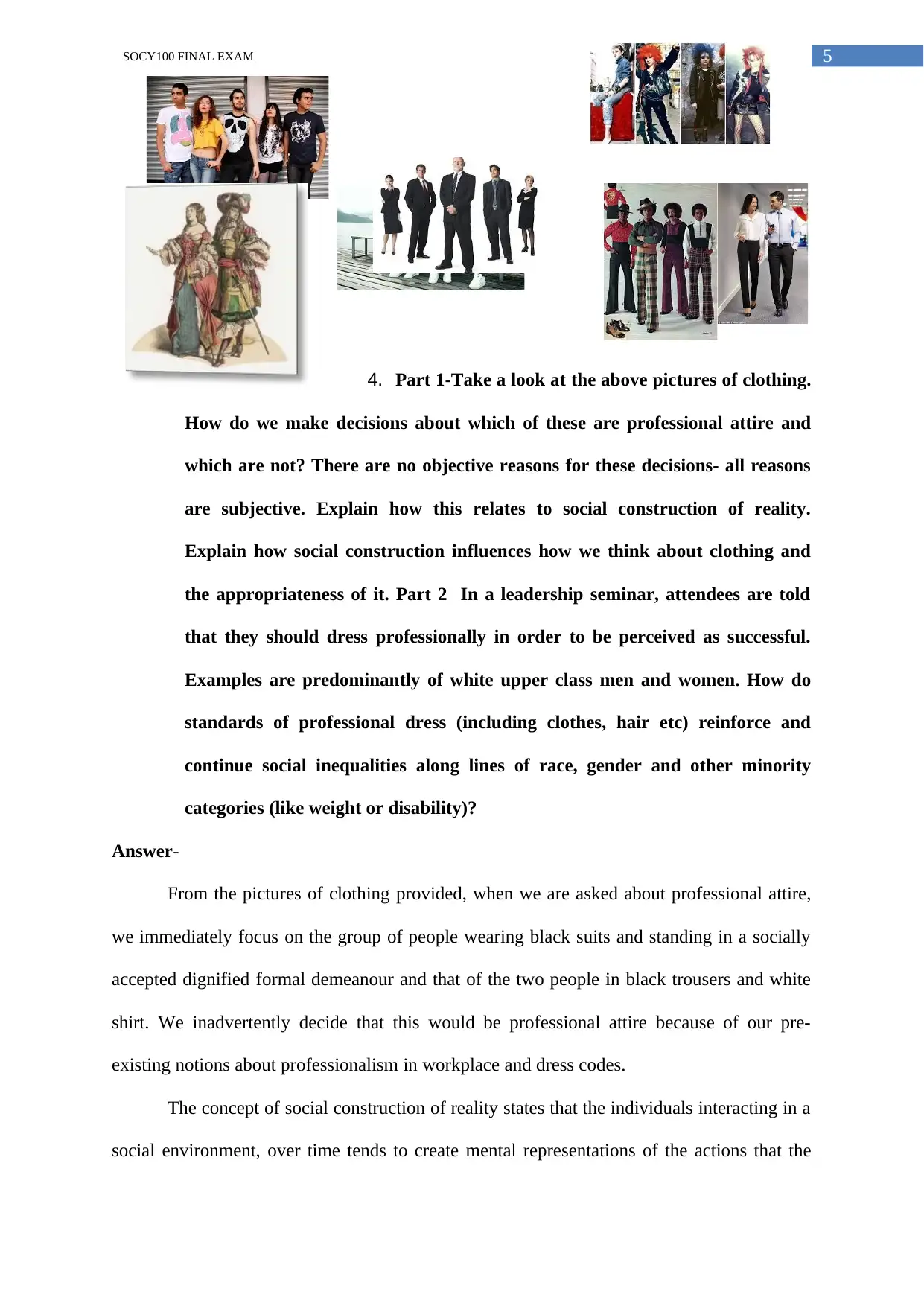
5SOCY100 FINAL EXAM
4. Part 1-Take a look at the above pictures of clothing.
How do we make decisions about which of these are professional attire and
which are not? There are no objective reasons for these decisions- all reasons
are subjective. Explain how this relates to social construction of reality.
Explain how social construction influences how we think about clothing and
the appropriateness of it. Part 2 In a leadership seminar, attendees are told
that they should dress professionally in order to be perceived as successful.
Examples are predominantly of white upper class men and women. How do
standards of professional dress (including clothes, hair etc) reinforce and
continue social inequalities along lines of race, gender and other minority
categories (like weight or disability)?
Answer-
From the pictures of clothing provided, when we are asked about professional attire,
we immediately focus on the group of people wearing black suits and standing in a socially
accepted dignified formal demeanour and that of the two people in black trousers and white
shirt. We inadvertently decide that this would be professional attire because of our pre-
existing notions about professionalism in workplace and dress codes.
The concept of social construction of reality states that the individuals interacting in a
social environment, over time tends to create mental representations of the actions that the
4. Part 1-Take a look at the above pictures of clothing.
How do we make decisions about which of these are professional attire and
which are not? There are no objective reasons for these decisions- all reasons
are subjective. Explain how this relates to social construction of reality.
Explain how social construction influences how we think about clothing and
the appropriateness of it. Part 2 In a leadership seminar, attendees are told
that they should dress professionally in order to be perceived as successful.
Examples are predominantly of white upper class men and women. How do
standards of professional dress (including clothes, hair etc) reinforce and
continue social inequalities along lines of race, gender and other minority
categories (like weight or disability)?
Answer-
From the pictures of clothing provided, when we are asked about professional attire,
we immediately focus on the group of people wearing black suits and standing in a socially
accepted dignified formal demeanour and that of the two people in black trousers and white
shirt. We inadvertently decide that this would be professional attire because of our pre-
existing notions about professionalism in workplace and dress codes.
The concept of social construction of reality states that the individuals interacting in a
social environment, over time tends to create mental representations of the actions that the
⊘ This is a preview!⊘
Do you want full access?
Subscribe today to unlock all pages.

Trusted by 1+ million students worldwide
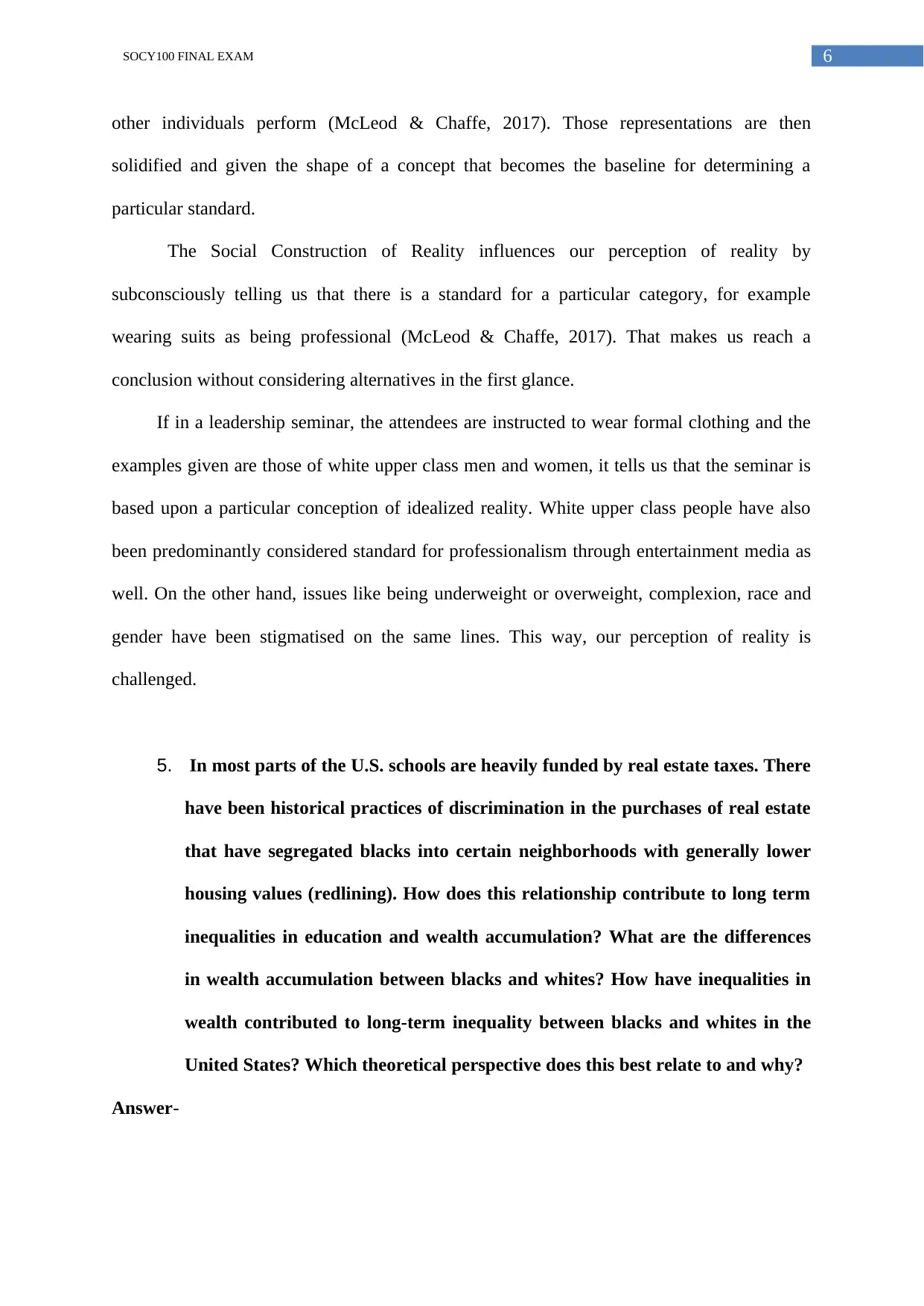
6SOCY100 FINAL EXAM
other individuals perform (McLeod & Chaffe, 2017). Those representations are then
solidified and given the shape of a concept that becomes the baseline for determining a
particular standard.
The Social Construction of Reality influences our perception of reality by
subconsciously telling us that there is a standard for a particular category, for example
wearing suits as being professional (McLeod & Chaffe, 2017). That makes us reach a
conclusion without considering alternatives in the first glance.
If in a leadership seminar, the attendees are instructed to wear formal clothing and the
examples given are those of white upper class men and women, it tells us that the seminar is
based upon a particular conception of idealized reality. White upper class people have also
been predominantly considered standard for professionalism through entertainment media as
well. On the other hand, issues like being underweight or overweight, complexion, race and
gender have been stigmatised on the same lines. This way, our perception of reality is
challenged.
5. In most parts of the U.S. schools are heavily funded by real estate taxes. There
have been historical practices of discrimination in the purchases of real estate
that have segregated blacks into certain neighborhoods with generally lower
housing values (redlining). How does this relationship contribute to long term
inequalities in education and wealth accumulation? What are the differences
in wealth accumulation between blacks and whites? How have inequalities in
wealth contributed to long-term inequality between blacks and whites in the
United States? Which theoretical perspective does this best relate to and why?
Answer-
other individuals perform (McLeod & Chaffe, 2017). Those representations are then
solidified and given the shape of a concept that becomes the baseline for determining a
particular standard.
The Social Construction of Reality influences our perception of reality by
subconsciously telling us that there is a standard for a particular category, for example
wearing suits as being professional (McLeod & Chaffe, 2017). That makes us reach a
conclusion without considering alternatives in the first glance.
If in a leadership seminar, the attendees are instructed to wear formal clothing and the
examples given are those of white upper class men and women, it tells us that the seminar is
based upon a particular conception of idealized reality. White upper class people have also
been predominantly considered standard for professionalism through entertainment media as
well. On the other hand, issues like being underweight or overweight, complexion, race and
gender have been stigmatised on the same lines. This way, our perception of reality is
challenged.
5. In most parts of the U.S. schools are heavily funded by real estate taxes. There
have been historical practices of discrimination in the purchases of real estate
that have segregated blacks into certain neighborhoods with generally lower
housing values (redlining). How does this relationship contribute to long term
inequalities in education and wealth accumulation? What are the differences
in wealth accumulation between blacks and whites? How have inequalities in
wealth contributed to long-term inequality between blacks and whites in the
United States? Which theoretical perspective does this best relate to and why?
Answer-
Paraphrase This Document
Need a fresh take? Get an instant paraphrase of this document with our AI Paraphraser
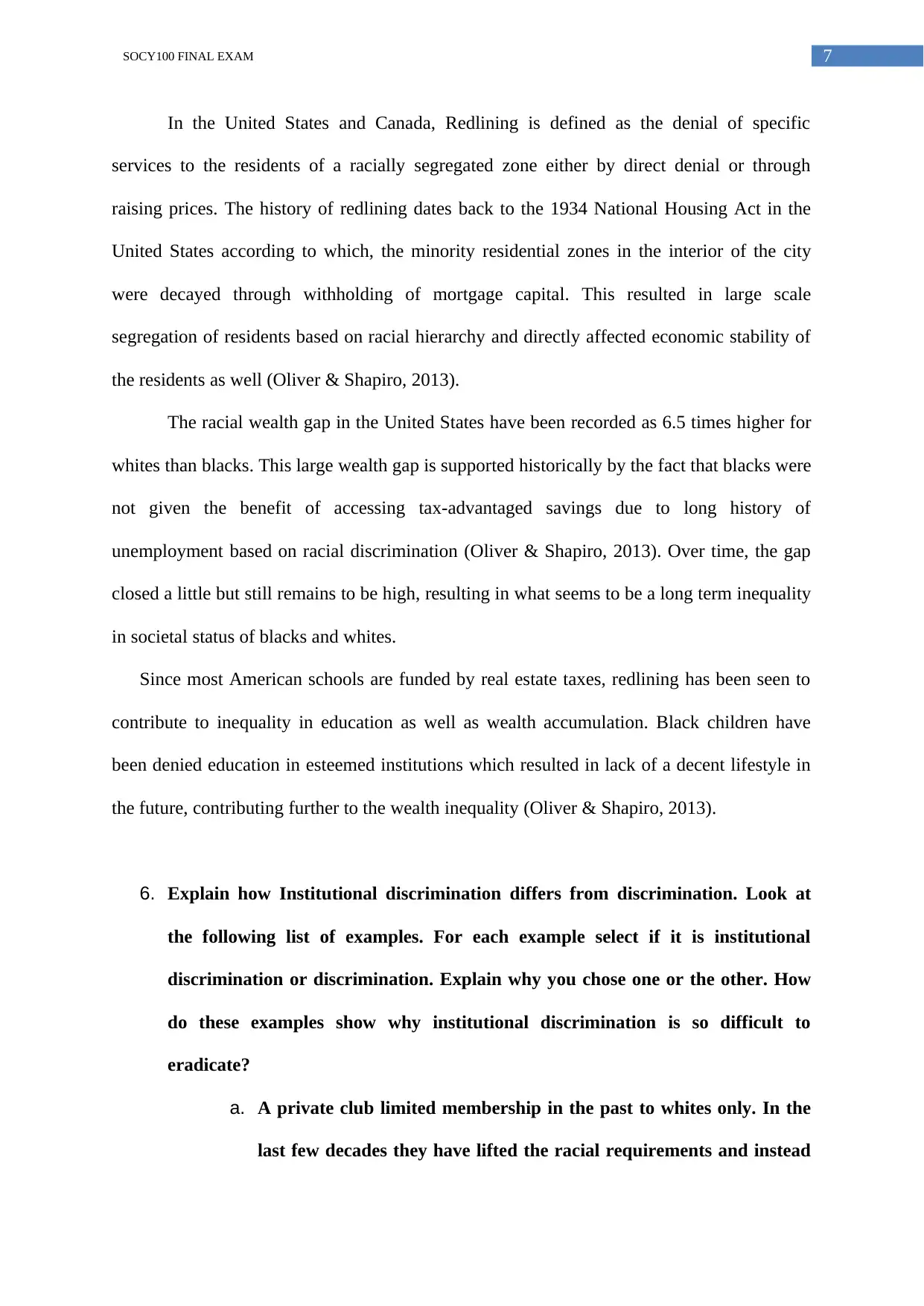
7SOCY100 FINAL EXAM
In the United States and Canada, Redlining is defined as the denial of specific
services to the residents of a racially segregated zone either by direct denial or through
raising prices. The history of redlining dates back to the 1934 National Housing Act in the
United States according to which, the minority residential zones in the interior of the city
were decayed through withholding of mortgage capital. This resulted in large scale
segregation of residents based on racial hierarchy and directly affected economic stability of
the residents as well (Oliver & Shapiro, 2013).
The racial wealth gap in the United States have been recorded as 6.5 times higher for
whites than blacks. This large wealth gap is supported historically by the fact that blacks were
not given the benefit of accessing tax-advantaged savings due to long history of
unemployment based on racial discrimination (Oliver & Shapiro, 2013). Over time, the gap
closed a little but still remains to be high, resulting in what seems to be a long term inequality
in societal status of blacks and whites.
Since most American schools are funded by real estate taxes, redlining has been seen to
contribute to inequality in education as well as wealth accumulation. Black children have
been denied education in esteemed institutions which resulted in lack of a decent lifestyle in
the future, contributing further to the wealth inequality (Oliver & Shapiro, 2013).
6. Explain how Institutional discrimination differs from discrimination. Look at
the following list of examples. For each example select if it is institutional
discrimination or discrimination. Explain why you chose one or the other. How
do these examples show why institutional discrimination is so difficult to
eradicate?
a. A private club limited membership in the past to whites only. In the
last few decades they have lifted the racial requirements and instead
In the United States and Canada, Redlining is defined as the denial of specific
services to the residents of a racially segregated zone either by direct denial or through
raising prices. The history of redlining dates back to the 1934 National Housing Act in the
United States according to which, the minority residential zones in the interior of the city
were decayed through withholding of mortgage capital. This resulted in large scale
segregation of residents based on racial hierarchy and directly affected economic stability of
the residents as well (Oliver & Shapiro, 2013).
The racial wealth gap in the United States have been recorded as 6.5 times higher for
whites than blacks. This large wealth gap is supported historically by the fact that blacks were
not given the benefit of accessing tax-advantaged savings due to long history of
unemployment based on racial discrimination (Oliver & Shapiro, 2013). Over time, the gap
closed a little but still remains to be high, resulting in what seems to be a long term inequality
in societal status of blacks and whites.
Since most American schools are funded by real estate taxes, redlining has been seen to
contribute to inequality in education as well as wealth accumulation. Black children have
been denied education in esteemed institutions which resulted in lack of a decent lifestyle in
the future, contributing further to the wealth inequality (Oliver & Shapiro, 2013).
6. Explain how Institutional discrimination differs from discrimination. Look at
the following list of examples. For each example select if it is institutional
discrimination or discrimination. Explain why you chose one or the other. How
do these examples show why institutional discrimination is so difficult to
eradicate?
a. A private club limited membership in the past to whites only. In the
last few decades they have lifted the racial requirements and instead
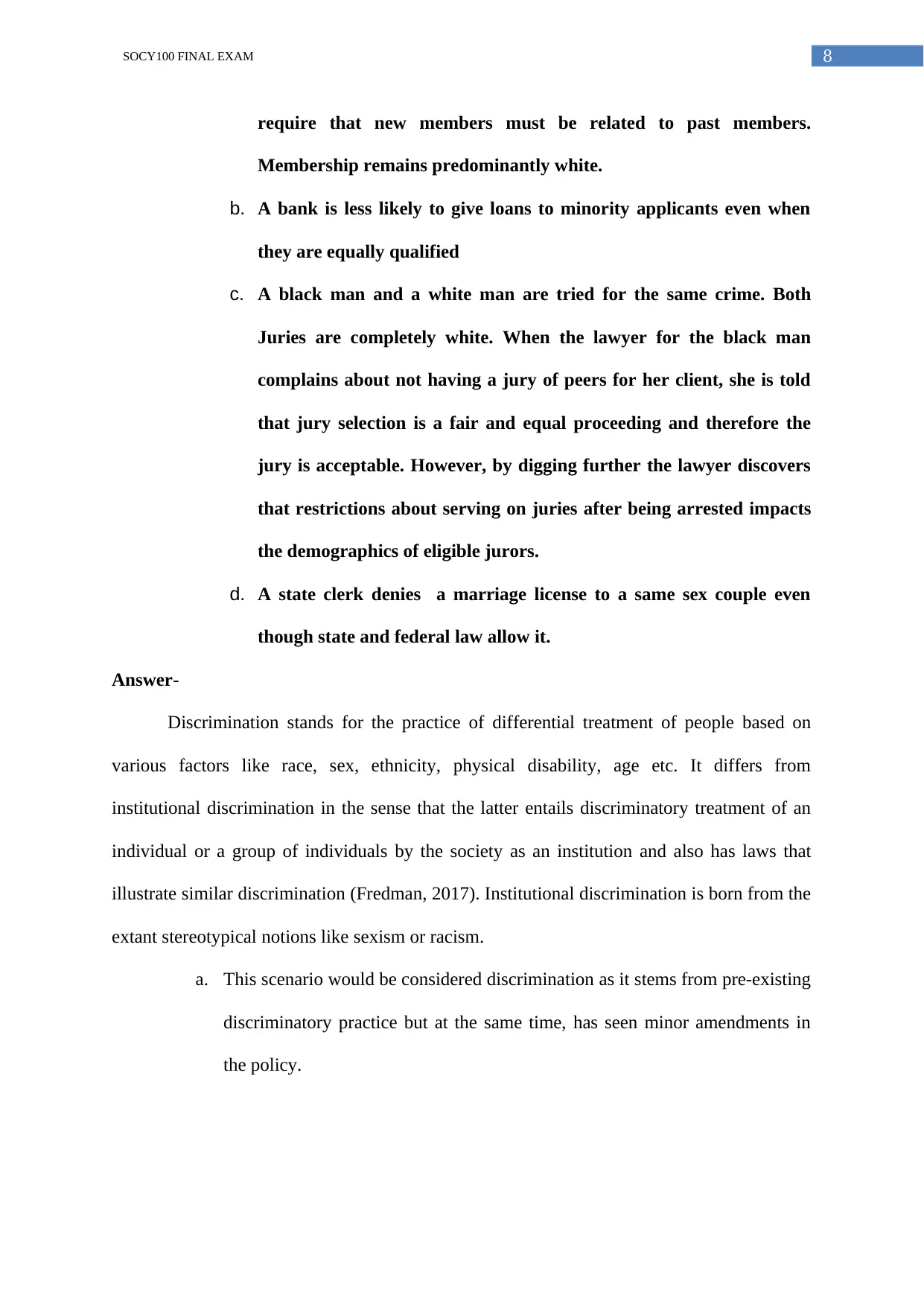
8SOCY100 FINAL EXAM
require that new members must be related to past members.
Membership remains predominantly white.
b. A bank is less likely to give loans to minority applicants even when
they are equally qualified
c. A black man and a white man are tried for the same crime. Both
Juries are completely white. When the lawyer for the black man
complains about not having a jury of peers for her client, she is told
that jury selection is a fair and equal proceeding and therefore the
jury is acceptable. However, by digging further the lawyer discovers
that restrictions about serving on juries after being arrested impacts
the demographics of eligible jurors.
d. A state clerk denies a marriage license to a same sex couple even
though state and federal law allow it.
Answer-
Discrimination stands for the practice of differential treatment of people based on
various factors like race, sex, ethnicity, physical disability, age etc. It differs from
institutional discrimination in the sense that the latter entails discriminatory treatment of an
individual or a group of individuals by the society as an institution and also has laws that
illustrate similar discrimination (Fredman, 2017). Institutional discrimination is born from the
extant stereotypical notions like sexism or racism.
a. This scenario would be considered discrimination as it stems from pre-existing
discriminatory practice but at the same time, has seen minor amendments in
the policy.
require that new members must be related to past members.
Membership remains predominantly white.
b. A bank is less likely to give loans to minority applicants even when
they are equally qualified
c. A black man and a white man are tried for the same crime. Both
Juries are completely white. When the lawyer for the black man
complains about not having a jury of peers for her client, she is told
that jury selection is a fair and equal proceeding and therefore the
jury is acceptable. However, by digging further the lawyer discovers
that restrictions about serving on juries after being arrested impacts
the demographics of eligible jurors.
d. A state clerk denies a marriage license to a same sex couple even
though state and federal law allow it.
Answer-
Discrimination stands for the practice of differential treatment of people based on
various factors like race, sex, ethnicity, physical disability, age etc. It differs from
institutional discrimination in the sense that the latter entails discriminatory treatment of an
individual or a group of individuals by the society as an institution and also has laws that
illustrate similar discrimination (Fredman, 2017). Institutional discrimination is born from the
extant stereotypical notions like sexism or racism.
a. This scenario would be considered discrimination as it stems from pre-existing
discriminatory practice but at the same time, has seen minor amendments in
the policy.
⊘ This is a preview!⊘
Do you want full access?
Subscribe today to unlock all pages.

Trusted by 1+ million students worldwide
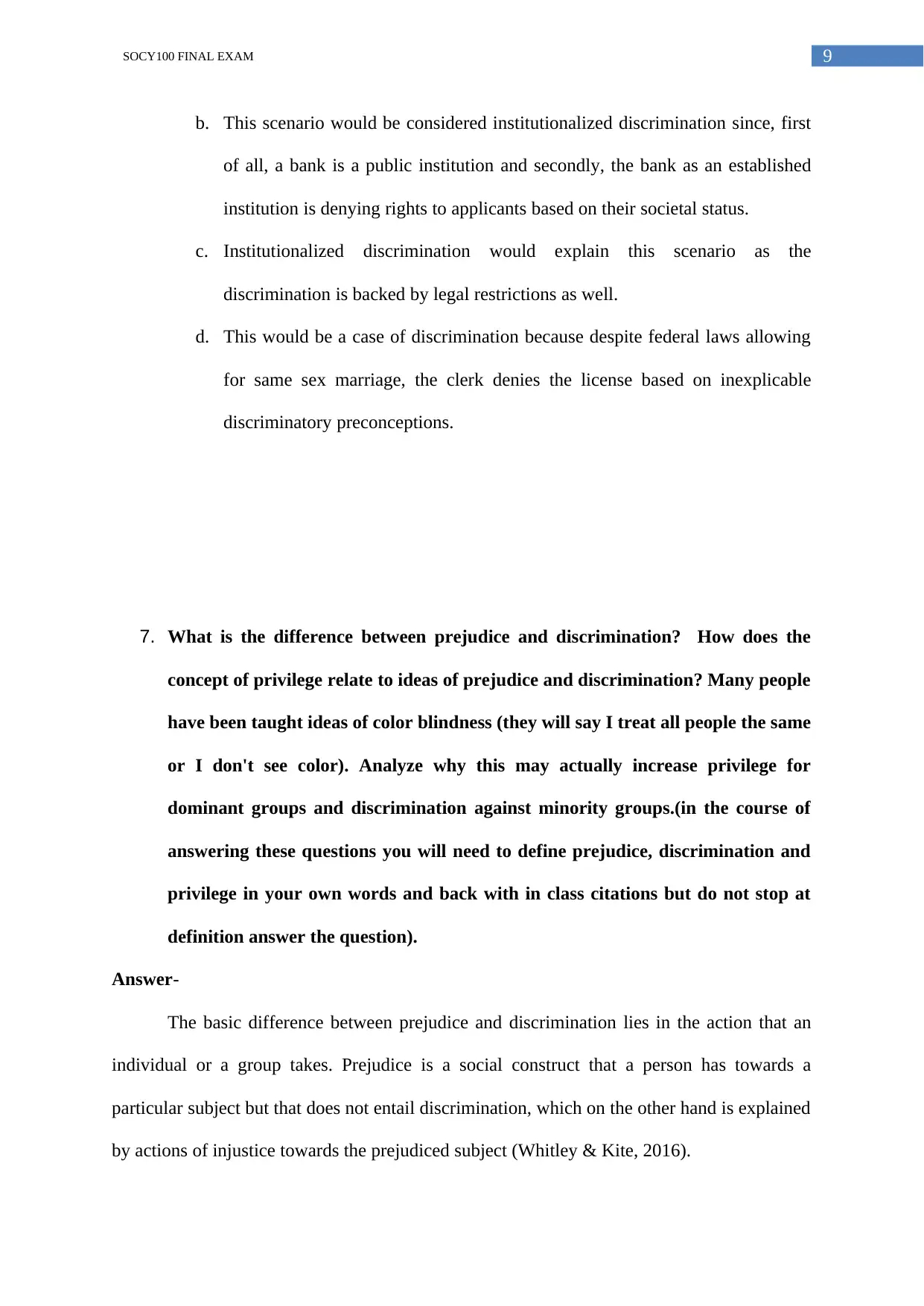
9SOCY100 FINAL EXAM
b. This scenario would be considered institutionalized discrimination since, first
of all, a bank is a public institution and secondly, the bank as an established
institution is denying rights to applicants based on their societal status.
c. Institutionalized discrimination would explain this scenario as the
discrimination is backed by legal restrictions as well.
d. This would be a case of discrimination because despite federal laws allowing
for same sex marriage, the clerk denies the license based on inexplicable
discriminatory preconceptions.
7. What is the difference between prejudice and discrimination? How does the
concept of privilege relate to ideas of prejudice and discrimination? Many people
have been taught ideas of color blindness (they will say I treat all people the same
or I don't see color). Analyze why this may actually increase privilege for
dominant groups and discrimination against minority groups.(in the course of
answering these questions you will need to define prejudice, discrimination and
privilege in your own words and back with in class citations but do not stop at
definition answer the question).
Answer-
The basic difference between prejudice and discrimination lies in the action that an
individual or a group takes. Prejudice is a social construct that a person has towards a
particular subject but that does not entail discrimination, which on the other hand is explained
by actions of injustice towards the prejudiced subject (Whitley & Kite, 2016).
b. This scenario would be considered institutionalized discrimination since, first
of all, a bank is a public institution and secondly, the bank as an established
institution is denying rights to applicants based on their societal status.
c. Institutionalized discrimination would explain this scenario as the
discrimination is backed by legal restrictions as well.
d. This would be a case of discrimination because despite federal laws allowing
for same sex marriage, the clerk denies the license based on inexplicable
discriminatory preconceptions.
7. What is the difference between prejudice and discrimination? How does the
concept of privilege relate to ideas of prejudice and discrimination? Many people
have been taught ideas of color blindness (they will say I treat all people the same
or I don't see color). Analyze why this may actually increase privilege for
dominant groups and discrimination against minority groups.(in the course of
answering these questions you will need to define prejudice, discrimination and
privilege in your own words and back with in class citations but do not stop at
definition answer the question).
Answer-
The basic difference between prejudice and discrimination lies in the action that an
individual or a group takes. Prejudice is a social construct that a person has towards a
particular subject but that does not entail discrimination, which on the other hand is explained
by actions of injustice towards the prejudiced subject (Whitley & Kite, 2016).
Paraphrase This Document
Need a fresh take? Get an instant paraphrase of this document with our AI Paraphraser
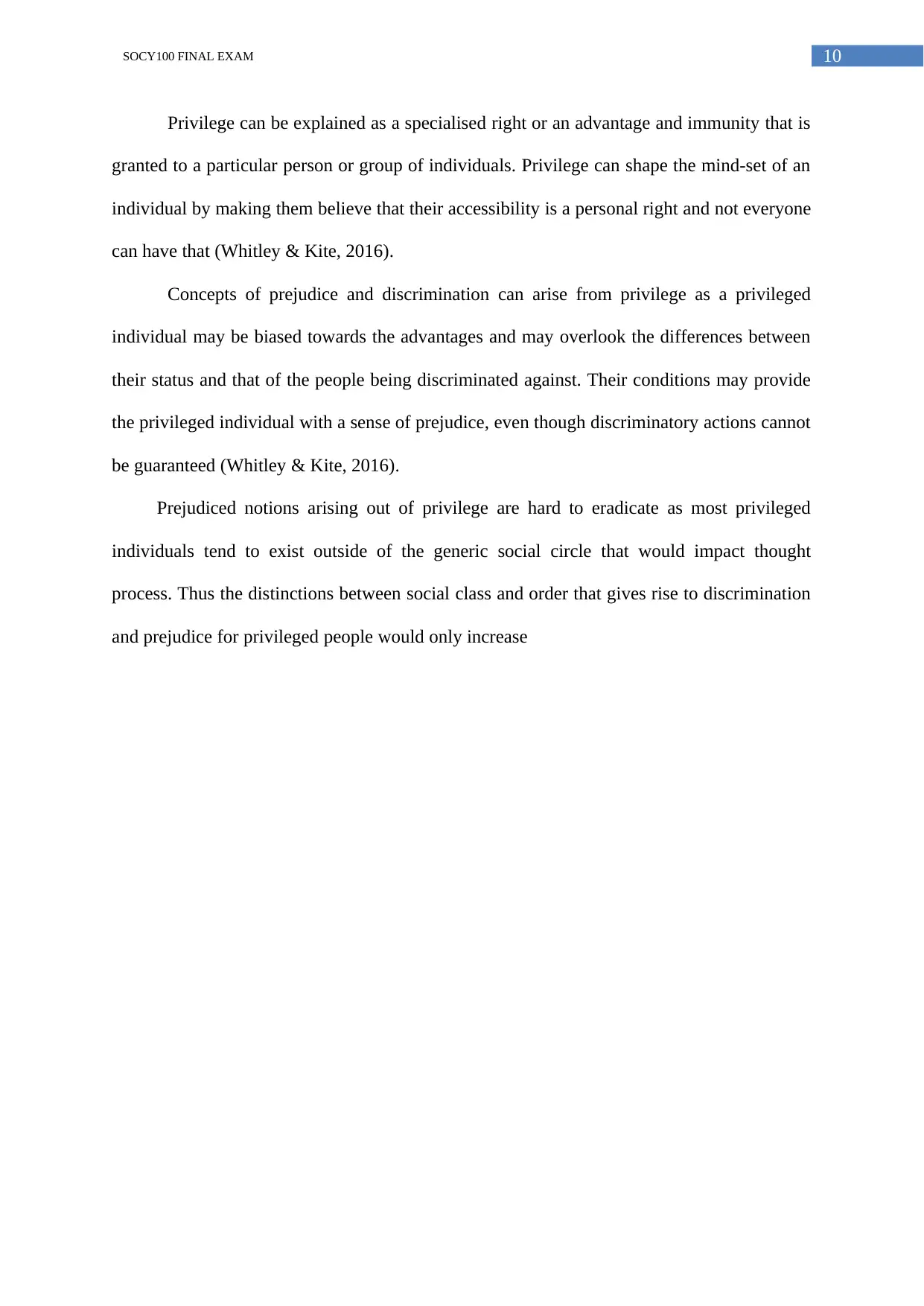
10SOCY100 FINAL EXAM
Privilege can be explained as a specialised right or an advantage and immunity that is
granted to a particular person or group of individuals. Privilege can shape the mind-set of an
individual by making them believe that their accessibility is a personal right and not everyone
can have that (Whitley & Kite, 2016).
Concepts of prejudice and discrimination can arise from privilege as a privileged
individual may be biased towards the advantages and may overlook the differences between
their status and that of the people being discriminated against. Their conditions may provide
the privileged individual with a sense of prejudice, even though discriminatory actions cannot
be guaranteed (Whitley & Kite, 2016).
Prejudiced notions arising out of privilege are hard to eradicate as most privileged
individuals tend to exist outside of the generic social circle that would impact thought
process. Thus the distinctions between social class and order that gives rise to discrimination
and prejudice for privileged people would only increase
Privilege can be explained as a specialised right or an advantage and immunity that is
granted to a particular person or group of individuals. Privilege can shape the mind-set of an
individual by making them believe that their accessibility is a personal right and not everyone
can have that (Whitley & Kite, 2016).
Concepts of prejudice and discrimination can arise from privilege as a privileged
individual may be biased towards the advantages and may overlook the differences between
their status and that of the people being discriminated against. Their conditions may provide
the privileged individual with a sense of prejudice, even though discriminatory actions cannot
be guaranteed (Whitley & Kite, 2016).
Prejudiced notions arising out of privilege are hard to eradicate as most privileged
individuals tend to exist outside of the generic social circle that would impact thought
process. Thus the distinctions between social class and order that gives rise to discrimination
and prejudice for privileged people would only increase
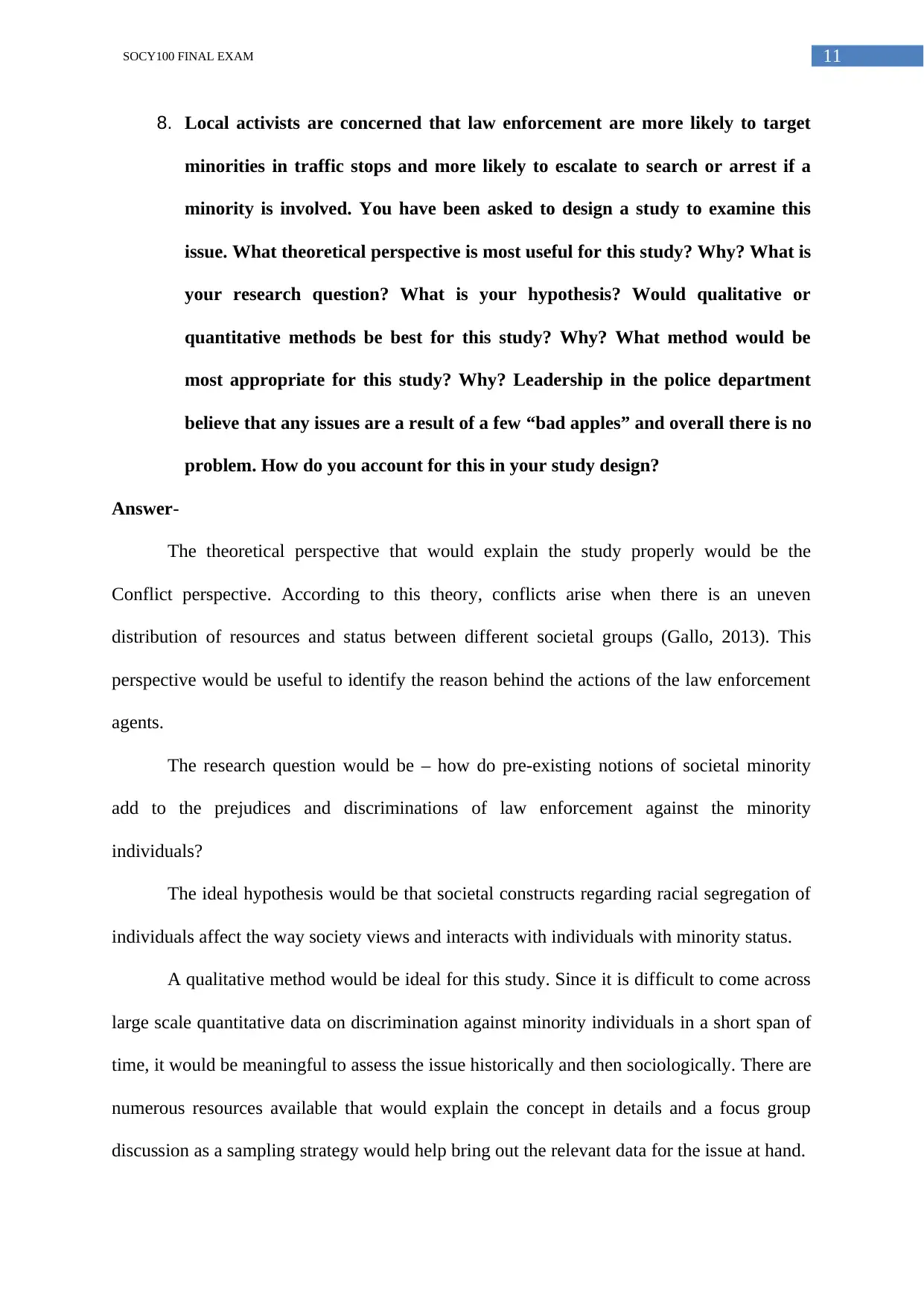
11SOCY100 FINAL EXAM
8. Local activists are concerned that law enforcement are more likely to target
minorities in traffic stops and more likely to escalate to search or arrest if a
minority is involved. You have been asked to design a study to examine this
issue. What theoretical perspective is most useful for this study? Why? What is
your research question? What is your hypothesis? Would qualitative or
quantitative methods be best for this study? Why? What method would be
most appropriate for this study? Why? Leadership in the police department
believe that any issues are a result of a few “bad apples” and overall there is no
problem. How do you account for this in your study design?
Answer-
The theoretical perspective that would explain the study properly would be the
Conflict perspective. According to this theory, conflicts arise when there is an uneven
distribution of resources and status between different societal groups (Gallo, 2013). This
perspective would be useful to identify the reason behind the actions of the law enforcement
agents.
The research question would be – how do pre-existing notions of societal minority
add to the prejudices and discriminations of law enforcement against the minority
individuals?
The ideal hypothesis would be that societal constructs regarding racial segregation of
individuals affect the way society views and interacts with individuals with minority status.
A qualitative method would be ideal for this study. Since it is difficult to come across
large scale quantitative data on discrimination against minority individuals in a short span of
time, it would be meaningful to assess the issue historically and then sociologically. There are
numerous resources available that would explain the concept in details and a focus group
discussion as a sampling strategy would help bring out the relevant data for the issue at hand.
8. Local activists are concerned that law enforcement are more likely to target
minorities in traffic stops and more likely to escalate to search or arrest if a
minority is involved. You have been asked to design a study to examine this
issue. What theoretical perspective is most useful for this study? Why? What is
your research question? What is your hypothesis? Would qualitative or
quantitative methods be best for this study? Why? What method would be
most appropriate for this study? Why? Leadership in the police department
believe that any issues are a result of a few “bad apples” and overall there is no
problem. How do you account for this in your study design?
Answer-
The theoretical perspective that would explain the study properly would be the
Conflict perspective. According to this theory, conflicts arise when there is an uneven
distribution of resources and status between different societal groups (Gallo, 2013). This
perspective would be useful to identify the reason behind the actions of the law enforcement
agents.
The research question would be – how do pre-existing notions of societal minority
add to the prejudices and discriminations of law enforcement against the minority
individuals?
The ideal hypothesis would be that societal constructs regarding racial segregation of
individuals affect the way society views and interacts with individuals with minority status.
A qualitative method would be ideal for this study. Since it is difficult to come across
large scale quantitative data on discrimination against minority individuals in a short span of
time, it would be meaningful to assess the issue historically and then sociologically. There are
numerous resources available that would explain the concept in details and a focus group
discussion as a sampling strategy would help bring out the relevant data for the issue at hand.
⊘ This is a preview!⊘
Do you want full access?
Subscribe today to unlock all pages.

Trusted by 1+ million students worldwide
1 out of 19
Your All-in-One AI-Powered Toolkit for Academic Success.
+13062052269
info@desklib.com
Available 24*7 on WhatsApp / Email
![[object Object]](/_next/static/media/star-bottom.7253800d.svg)
Unlock your academic potential
Copyright © 2020–2025 A2Z Services. All Rights Reserved. Developed and managed by ZUCOL.
